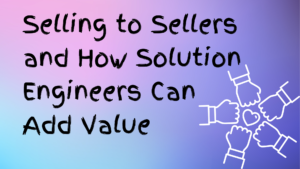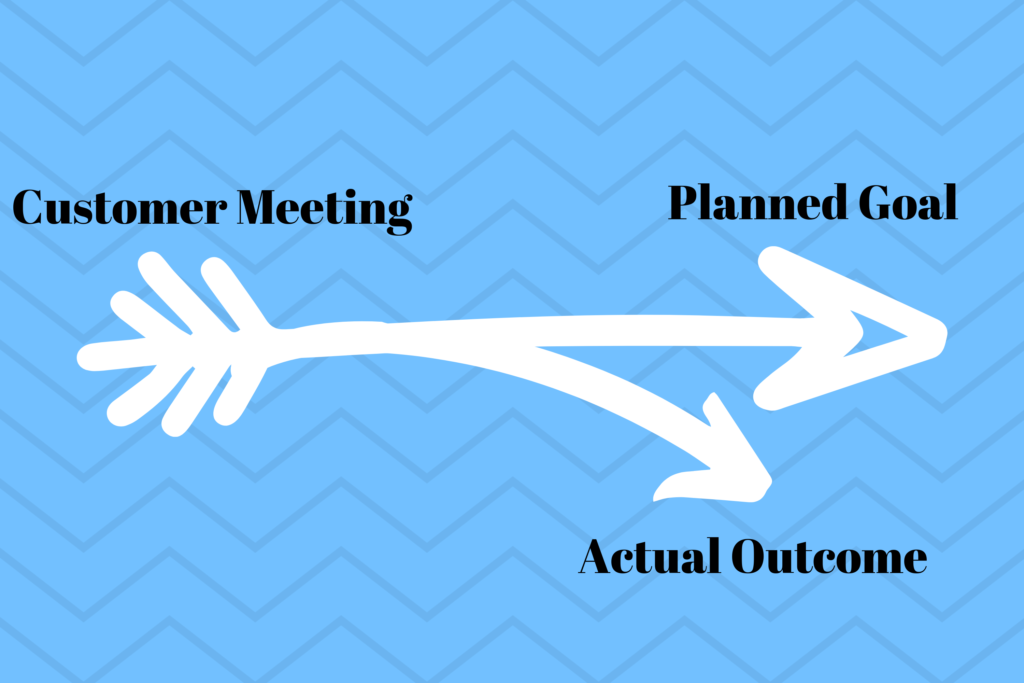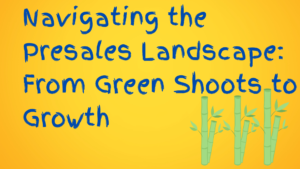
Meeting New Customers vs. Meeting Old Customers

By Ramzi Marjaba
Meeting customers is something we do on a consistent basis, at least we should be. My former manager once mentioned that we should be in contact with at least one customer once a day, even if we are working on a demo, even if we are on vacation (I think he was joking but not 100% sure), and even if it’s just a phone call.
As Sales Engineers, many of the customers we might meet are new customers, but many are repeat customers as well. Keep in mind that the best customers are the ones you already have, so if you are not seeing your existing customers, you are missing something.
I wanted to use this post to differentiate the styles and what goes on when meeting new customers v.s old customers.
But first, let’s talk about what’s common between the two.
1- Having a planned outcome:
Every meeting should have a goal. What are you trying to achieve? What action do you want the customer to take? There are so many different goals that our meetings can have, and these are very similar to the goals Account Managers would have.
For example, your goal could be to debrief with the sponsor after a demo or try to get a referral to another team or company. Identifying the customer’s needs is a big one usually.
The meetings should be crafted to achieve these goals. So if my goal is to understand what the customer wants, i.e. perform a needs analysis, I craft it by setting expectations, ask my Account Manager to set the expectations, then leave my laptop in the car so we can have a conversation without being forced into a presentation if that was not the purpose of the meeting.
If I want to perform a demo, I would set the customer expectation to that fact and what I will be covering. I’d also make sure I have wifi, a projector and a meeting room.
Just note that sometimes the goals change during the meeting sometime, and as sales engineers we have to be flexible. I’ve been in meetings where one word from the customer throw opens up other avenues that can be helpful.
One meeting I had, my goal was just to make sure that everything was working well, and to see if my customer has any needs upcoming. It was not a formal meeting, it was more of a drop in. We got to chatting and I was just trying to probe to see if there are any future needs, and there wasn’t any. Then all of a sudden he asked me if I’ve ever talked to a friend of his, he was looking for something that we usually offer. I b-lined down 2 floors and straight into that person’s office. A year later we had the PO and the competition was never involved. Goal -> find more opportunities with a current customer, outcome -> made a new one.
2- Mentally Preparing for a meeting
Meeting with customers does not come easy to some people, to others it comes too easy. I think I’ve mentioned before once or twice that I am an introvert. I also have 2 kids, 1 and 3 as of this writing. Although it’s getting better, sleep is still considered more of a luxury than a need. Well guess what, no one cares. Many have been in my situation before and they still have to do their job. The SE job however is a bit different. SEs need to see customers, we’ve already established that, no matter how tired or introverted we are. That just means that I have to consciously turn on my “extroversion” if you will. So I have a checklist that I through on my drive to the customer.
- Smile
- Happy to See the customer
- Goal that I want to achieve
- If new customer, did I do the research
- If existing customer, did I check my latest notes
- Do I have my tools, although I should check that before I leave the house, but not bad to do a mental check
- Opening line prepared? As an introvert, I find it useful to have an idea of what my first words would be. I never actually say them to the customer though.
- Do I have some new industry trends or story I can share with the customer?
Extroverts may have some other items in the checklist
- Smile
- Listen first mentality
- Goal that you want to achieve
- If new customer, did you do the research
- If existing customer, did you check my latest notes
- Do you have your tools
You can share your checklist in the comments below.
3- Dress Code:
Let me preface this by saying if you are coming to me for style advice, you’ve come to the right place if the answer is to buy multiples of the same shirt, 1 pair of pants and 1 pair of shoes and abuse the life out of them. If you are actually looking for clothing diversity, then you and I will never see eye to eye.
Now that I’m back from that tangent, what is the dress code for your customers? Here’s the general rule that I have: Be as dressy or as casual as your customers. Always err on the side of being a bit overdressed than being a bit underdressed.
Also there is a limit to how well or casual you dress. If you are working with a financial industry and you know the customers wear suits, well there you go, you’re wearing a suit. If you’re in my industry (networking) and your customers are wearing shorts and sandals, unfortunately, that would not be an option for you. In my mind the minimum would be a pair of jeans and a polo or dress shirt. Oh I wish I can wear shorts!!!!!
No matter what you wear, it goes without saying that the clothes should be clean, ironed and coordinated. It’s not about looking snazzy, it’s about being respectful to the customer.
As for my female readers, I’m pretty sure you want don’t want advice from me about what to wear. My wife doesn’t and she has good judgment. However if you have any suggestions or opinions, please comment below and start that conversation.
New let’s talk about the differences of between meeting new customers vs there regular customers, starting with meeting new customers
Meeting New Customers
When meeting customers for the first time, the feel of it is more formal, like a first date. The sales team is usually still gauging the customer, if he or she is personable, laughs at jokes, open with the requirements or if the customer only wants to gather information. The customer is trying to gauge the sales team. Some salespeople give the majority a bad name, so the customer is trying to figure out if the account team are people that they can trust.
The sales team is also trying to find a personal connection with them to move them beyond being just another sales guy and sales engineer. At the same time, the sales guy is trying to understand the timeline of the project and the budget while the SE is digging into identifying the customer’s needs without making it sound like an interrogation.
Sales Engineers, especially beginner sales engineers show up to meetings only to find out it was not qualified properly. Either the services that they offer does not match the problem the customer is facing, or the customer does not have any budget to buy. More senior Sales Engineers know how to protect their time and qualify the meeting with their Account Managers first.
Not only the first meetings can be unqualified, they customer expectations might not be set properly. I’ve been to too many meetings with new customers where they are expecting a demonstration of some sort. This has happened more often than not while going through a partner channel, at least for me.
Meeting with Existing Customers
Contrast that with meeting with your already existing customers. Usually those meetings are a lot more casual. Depending on how often you meet these customers, and what your interactions are like, the meetings are less discovery or demos and more friends helping out each other. I have several customers who are no longer customers but we still friends and we know personal information about each other and we actively try to hangout when we have time.
These meetings are mostly qualified since you know the customers what they need. Based on your experience and history with the customer you can usually tell if they will buy or if they are just tire kickers.
Existing customers are also more open to having discussions over breakfast, lunch or dinner. This allows the customer to step out of the business setting which tends to relax them a bit and they would be more open to providing more information or leads to other potential customers.
This also helps in another kind of customer meeting, the drop in. This is my favorite kind of meeting. Here are a few tips:
1- It helps to have access to the customer building. I usually get a badge to enter the premises since I tend to show up all the time and that way the customer does not escort me around.
2- If you have many customers within a single customer premises, try to diversify those who you visit. This helps in people not getting tired of you for showing up all the time.
3- Always give the customer the option to tell you to leave them alone if they are busy. That helps with point number 2.
4- Always assume people are on conference calls before walking into their cubicles, and if they are, try to get their attention just so you can give a silent “hi” and walk away. More often than not the customer is on mute and gets off the call to chat with me for a couple of minutes.
5- Don’t forget about certain customers. Make sure you touch all the current customers you have periodically.
6- Weight your visits more to those who give you more business, but don’t completely forget about those who don’t. Use your judgment on how often you visit those.
7- Ask for referrals or new news.
Although meeting new customers is a little different than meeting existing customers, the goal is to increase the comfort level of meeting these new customers, and also moving the comfort level of the customer from playing everything close to the vest to having a friendly relationship.
What are some tips you have to move the needle? Either for you to become comfortable with new customers? Or having a friendly relationship with customers?
Stay in the loop
Subscribe to get our latest content by email.
Success! Now check your email to confirm your subscription.



